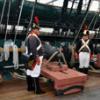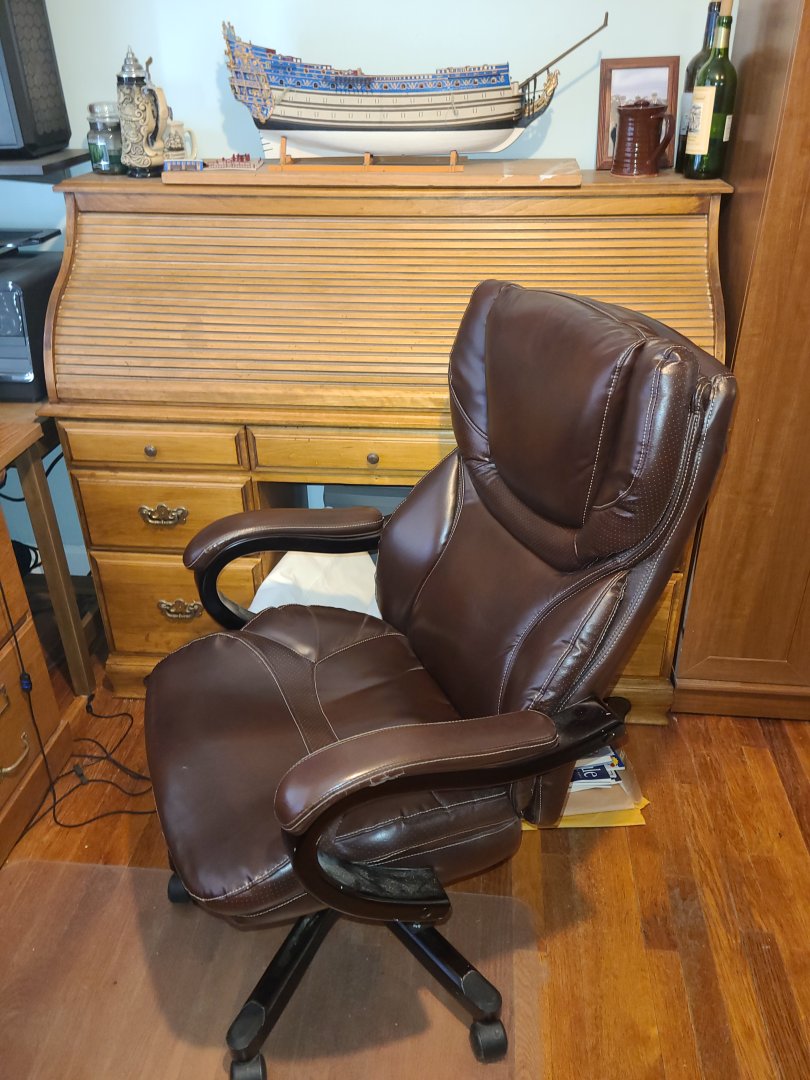-
Posts
1,935 -
Joined
-
Last visited
Content Type
Profiles
Forums
Gallery
Events
Everything posted by popeye2sea
-
These are called mast tackle pendants. They are fitted first over the masthead because they are initially used to heave taut the shrouds when setting up the deadeye laniards. Thereafter, they are employed using heavy tackles to hoist gear and cargo aboard the ship. Regards, Henry
- 301 replies
-
- Constitution
- Bluejacket Shipcrafters
-
(and 1 more)
Tagged with:
-
Honestly, I don't think they would for several reasons. For example: Just one more thing to get blown out in a storm. The helmsman needs to be able to look up at the sails to make sure they are still drawing properly and not luffing. They were not concerned at all with creature comforts. No ship I ever served in, ever rigged a tarpaulin rain cover when underway. That is only rigged in port to give cover and shade to visiting landlubbers or dignitaries. Or when holding special events on board. Regards, Henry
-
Hello Pak75, I can not speak to question one, but for the second, the tackles were left hooked on to the gun carriage. They acted as sort of a recoil brake as the cannon was fired. When the gun was run out to the in-battery position for firing, the tackle falls were flaked down on the deck, not coiled, so that they would run clear when the gun fired. Regards, Henry BTW, Do you have a name for us to use? We are a friendly bunch here.
-
Only the largest of vessels were fitted with four capstans.
- 27 replies
-
- capstan
- small boats
-
(and 1 more)
Tagged with:
-
Manpower only. No capstan. Those are five part tackles and there are two on each boat. So the force needed for each hauling part is something like 200 pounds. Not difficult for a few sailors on each tackle. Regards, Henry
- 27 replies
-
- capstan
- small boats
-
(and 1 more)
Tagged with:
-
In order to set up a yard and stay hoisting rig (which is what that lifting rig is called) you need two separate hauling parts. One tackle is rigged over the main hatch with the tackle attached to the main stay. The other tackle is a yard tackle suspended from the lower yard arm. The lower blocks for both tackles come together and are hooked into the sling holding the load. In order to launch a boat. Step 1. Hoist away on the stay tackle, which is directly over the load, so that the load is high enough to clear the side bulwarks. The yard tackle holds fast or takes up slack. The stay tackle bears the load. Step 2. Haul the load outboard by heaving on the yard tackle. The stay tackle is eased as needed. Both tackles bear the load. Step 3. Once the load is directly beneath the yard tackle outboard of the ship, lower away on the yard tackle. Ease the stay tackle as needed. The stay tackle bears the load until the boat is in the water. The process is reversed for getting cargo into the ship. Regards, Henry P.S. The actual rig is slightly more complicated because you need relieving lifts and rolling tackles on the yard to help it bear the weight of the load. P.P.S I took a ship loading operations course for the US Navy Military Sealift Command. I found the yard and stay rig to be the most fun to rig and operate. The gantry crane with a container spreader being a close second. Regards, Henry
- 27 replies
-
- capstan
- small boats
-
(and 1 more)
Tagged with:
-
The 10/0 beads should be good to use. I used them for my main and fore yards, They may even be a bit too large. I think they may end up being too large for the upper yards. I will be looking for some 13/0 or so for those later. I would not use anything larger than 10/0. Regards, Henry
-
I believe rope was sold by the fathom. Cables were made in lengths of 100 fathoms and different rope sizes were made to a certain weight standard. For instance 100 fathoms of 14 inch cable was to weigh 41 cwt. Cablets were made in 120 fathom lengths, and Hawsers were made in 130 fathom lengths. 130 fathoms of 4 inch hawser weighed 5 cwt. Information is from Steels elements of rope making. Regards, Henry
-
The standing part of the runner could either have an eye spliced in the end and the eye seized to ringbolt B, or there could be an eye spliced with a hook and hooked to the ringbolt. I am fairly certain that the runner would not be spliced directly through the ringbolt. The same can be said about the lower tackle block at ringbolt A. Except that is more likely to have a hook spliced into a becket on the block. Most rigging is set up so that removing the line does not entail cutting the rope itself so to facilitate using the tackle in a new location without the hassle of re-splicing the line or having to re-rig an entire line because it is now too short. It is far more efficient to just cut a seizing to remove or shift the tackle. Regards, Henry
-
On Constitution, the messenger runs from the capstan forward to a viol block mounted horizontally at the inside of the stem between the hawse holes on the gun deck. There are vertical rollers placed outboard of the various stanchions that the messenger may foul on in passing. The messenger is nipped to the anchor cable. As the cable comes aboard the water drips into and is captured in the manger. The cable passes below by means of a cutout in the fore corner of the main hatch grating where it is coiled two decks below on the cable tier in the orlop/hold. To answer your specific question, the main capstan, viol, hawse holes, messenger, and anchor cables are all on the gun deck. The cable tier is two decks below, accessible from the main hatch Regards, Henry
-

Block and Heart sizes question
popeye2sea replied to Kevin-the-lubber's topic in Masting, rigging and sails
A lot of modelers go the extra effort to approximate the correct size and style of blocks. Although there are far too many, in reality, to ever model correctly. Many modelers I see on MSW toss out the kit blocks in favor of making or purchasing more convincingly real versions. Regards, Henry -

Block and Heart sizes question
popeye2sea replied to Kevin-the-lubber's topic in Masting, rigging and sails
I think I read somewhere that the diameter of the lanyard for deadeyes and hearts is 1/2 (or slightly less) than the diameter of the stay or shroud. Regards, Henry -
The rational for a fully served shroud is to reduce chafe from the sails and associated rigging when the yards are braced around. So, if the mast that you are rigging only has a fore and aft sail, then I do not believe a fully served forward shroud is warranted. Regards, Henry
-

Chairs! Let’s see your chairs.
popeye2sea replied to Desertanimal's topic in Modeling tools and Workshop Equipment
Oh, I agree with you there. Mine is just too comfortable someti........zzzzzzz. -

Chairs! Let’s see your chairs.
popeye2sea replied to Desertanimal's topic in Modeling tools and Workshop Equipment
-
I'm really liking your work on the wales. At the risk of being overly critical, the upper scarf joint in this photo has a really odd placement, don't you think? It's really not serving any purpose. Regards, Henry
- 396 replies
-
- soleil royal
- Heller
-
(and 1 more)
Tagged with:
-
It was actually Oliver Wendell Holmes, SR. that wrote the poem. Henry
-
I disagree with this argument. Ships, any ships, and especially naval vessels, undergo frequent and constant modifications throughout their useful lives. How many times have you researched a build only to find that you had to choose what variant to build? Who is to say that the ship with modifications made is any less than the original vessel. Would you say that about yourself after a surgery? Are you not the same person? As I mentioned further above in this thread, Constitution is a living, continually changing vessel. Still an active US Navy ship. Still with the 12 to 13 percent of her original structure intact. 226 years old, she requires constant maintenance. That is what happens during the major dry dockings that happen at about twenty year intervals. During her early years "improvement and modernization" was nearly constant with captains making changes to rig and armament as they saw fit. The "committee" (US Navy History and Heritage Command) has been collecting and archiving materials since 1800. They are still using plans for Constitution from the 1790's to perform maintenance and repair on the vessel. Constitution is not, and never has been, a snapshot in time exhibit. You will find on board structures from her construction in 1795, masting and rigging modifications from the late 18th and early 19th centuries, armaments from the early 1800's, hull modifications from the early 1800's, equipment that was added in the 1920's, modern fire fighting systems, and modern materials used in maintenance. She is an amalgam of her 226 year history who's function is to promote the Navy's history and heritage. Also, she was never at risk of being broken up. That is a myth arising from the famous poem by Oliver Wendell Holmes. The Navy at that time was debating how much money to spend, what her role would be, and what the scope of her repairs should take. From the war of 1812 on, the Navy realized what a national treasure she was. Regards, Henry
-
To put this another way. Yard is a subset of Spar. The definition of a spar is a round wood or metal pole. Some items that can be called spars: Booms Gaffs Yards Masts Spreaders Pig Sticks Whiskers Marlinspike ( the dolphin striker, not the hand-held one for rope work) Regards, Henry
About us
Modelshipworld - Advancing Ship Modeling through Research
SSL Secured
Your security is important for us so this Website is SSL-Secured
NRG Mailing Address
Nautical Research Guild
237 South Lincoln Street
Westmont IL, 60559-1917
Model Ship World ® and the MSW logo are Registered Trademarks, and belong to the Nautical Research Guild (United States Patent and Trademark Office: No. 6,929,264 & No. 6,929,274, registered Dec. 20, 2022)
Helpful Links
About the NRG
If you enjoy building ship models that are historically accurate as well as beautiful, then The Nautical Research Guild (NRG) is just right for you.
The Guild is a non-profit educational organization whose mission is to “Advance Ship Modeling Through Research”. We provide support to our members in their efforts to raise the quality of their model ships.
The Nautical Research Guild has published our world-renowned quarterly magazine, The Nautical Research Journal, since 1955. The pages of the Journal are full of articles by accomplished ship modelers who show you how they create those exquisite details on their models, and by maritime historians who show you the correct details to build. The Journal is available in both print and digital editions. Go to the NRG web site (www.thenrg.org) to download a complimentary digital copy of the Journal. The NRG also publishes plan sets, books and compilations of back issues of the Journal and the former Ships in Scale and Model Ship Builder magazines.





